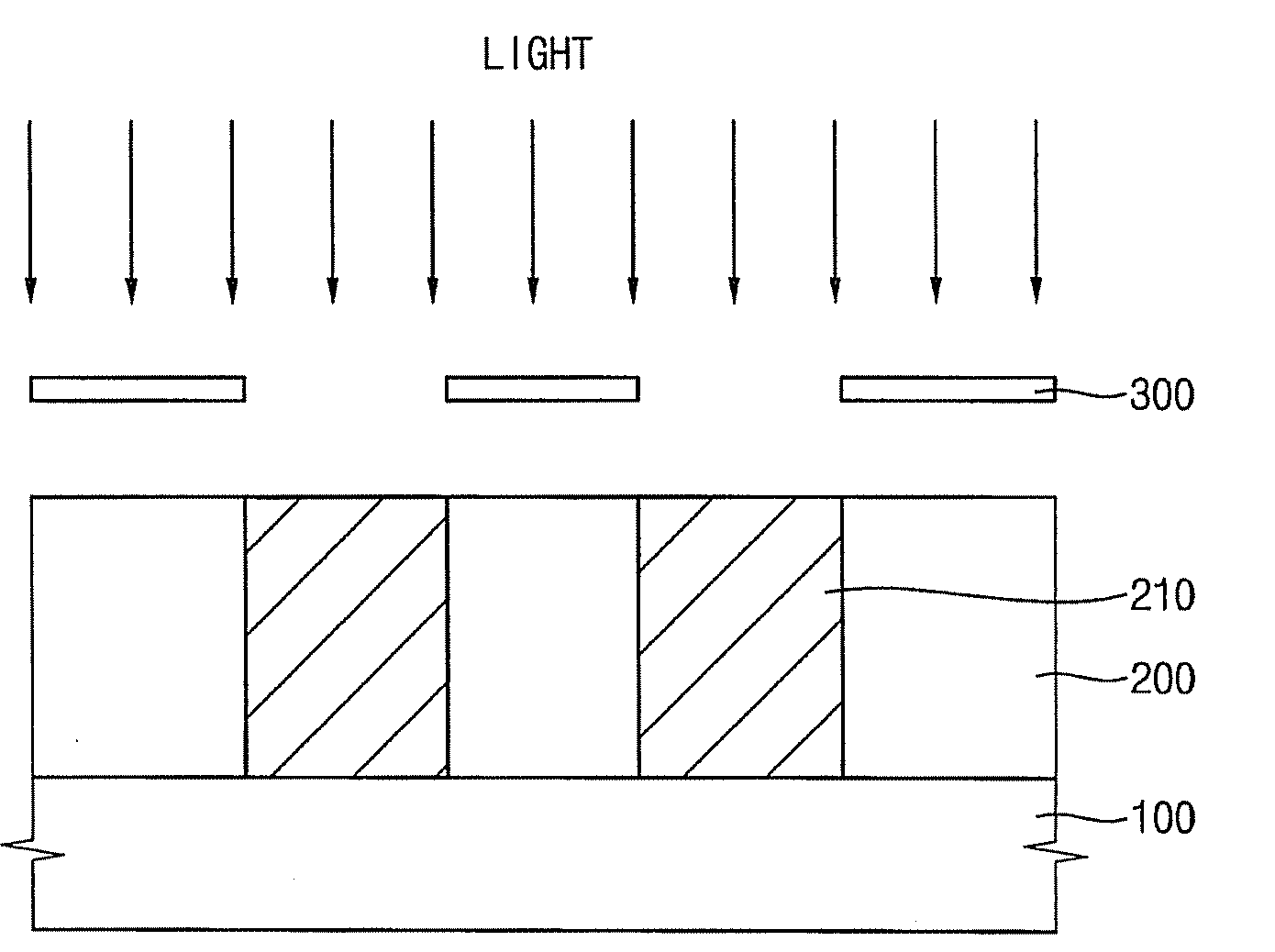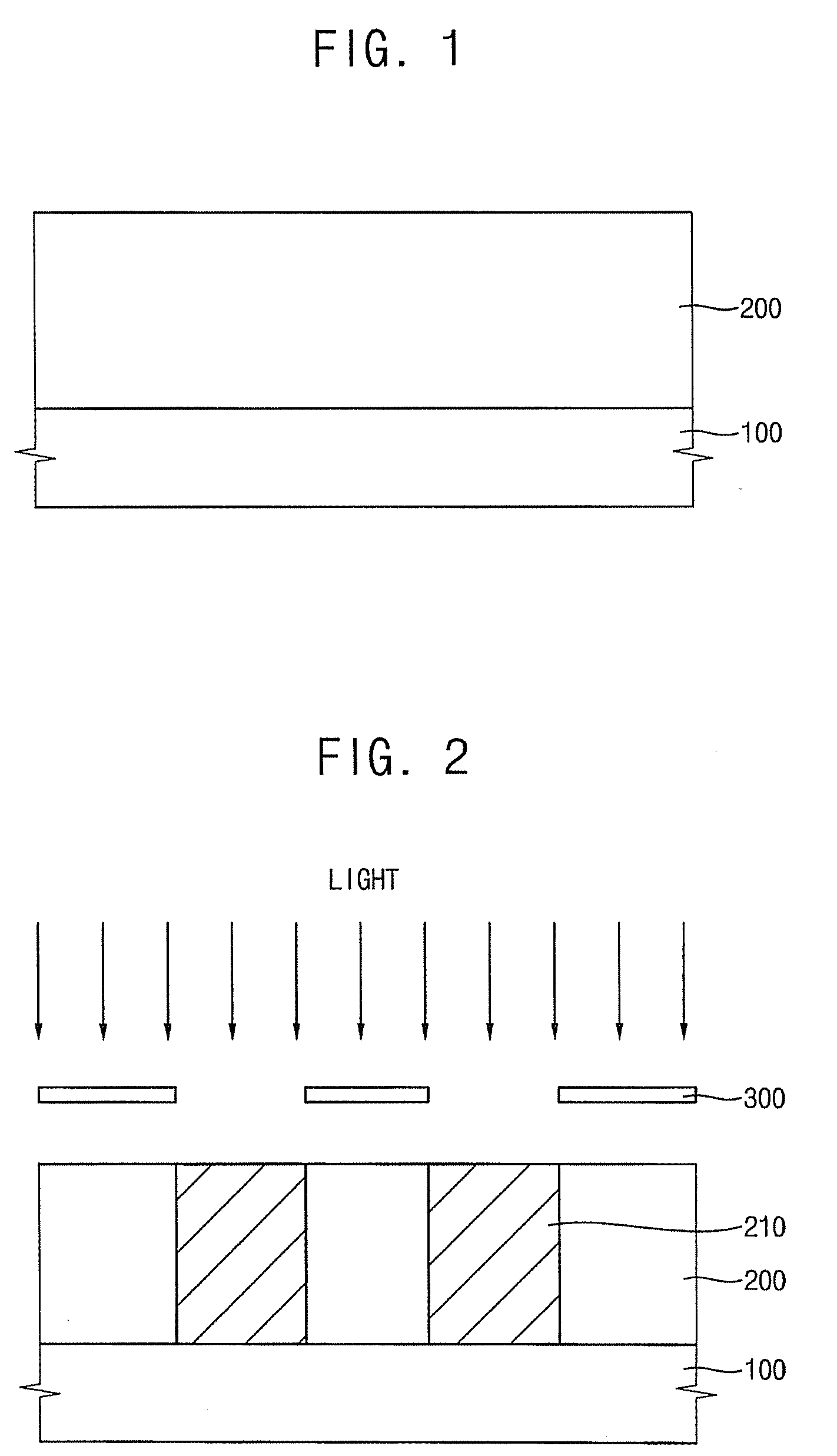Photoresist composition and method of forming a photoresist pattern using the same
a composition and composition technology, applied in the field of photoresist composition and a method of forming a photoresist pattern using, can solve the problems of easy damage to the photoresist pattern having the reverse-tapered shape, and the lower portion of the photoresist film is not provided with sufficient light energy, so as to improve the resolution of the photoresist pattern, prevent damage to the photoresist pattern, and reduce the
- Summary
- Abstract
- Description
- Claims
- Application Information
AI Technical Summary
Benefits of technology
Problems solved by technology
Method used
Image
Examples
example 1
[0064]A phenol mixture, including m-cresol and p-cresol in a weight ratio of about 40:60, was reacted with formaldehyde to prepare an alkali-soluble novolac resin, with weight-average molecular weight about 4,000 Daltons. About 100 parts by weight of the alkali-soluble novolac resin, about 2 parts by weight of a compound represented by the following Chemical Formula 5 as a photo-acid generator, about 5 parts by weight of hexamethylolmelamine hexamethylether as a cross-linker, about 0.6 parts by weight of UV yellow 1549 as an azo-based dye, about 1 parts by weight of trioctylamine, and about 400 parts by weight of propyleneglycol methylether propionate as a solvent, were mixed with each other to prepare a photoresist composition.
[0065]The photoresist composition was coated on a substrate to form a photoresist film. The photoresist film was exposed to light, baked and then developed to form a photoresist pattern. Sensitivity of the exposure process was about 140 mJ. The temperature of...
example 2
[0066]A photoresist composition was prepared through substantially the same method as Example 1, except that the photoresist composition included about 0.4 parts by weight of the compound represented by Chemical Formula 5 of Example 1 and about 1.6 parts by weight of a compound represented by the following Chemical Formula 6, as a photo-acid generator:
[0067]The photoresist composition was coated on a substrate to form a photoresist film. The photoresist film was exposed to light, baked, and then developed to form a photoresist pattern. The sensitivity of the exposure process was about 30 mJ. The temperature of a hot plate used in a baking process was about 130° C. A critical dimension of the photoresist pattern was about 2 μm. A thickness of the photoresist pattern was about 1.5 μm.
example 3
[0068]A photoresist composition was prepared through substantially the same method as Example 1 except that the photoresist composition included about 2 parts by weight of hexamethoxymethylmelamine and about 3 parts by weight of hexamethylolmelamine hexamethylether, as a cross-linker.
[0069]The photoresist composition was coated on a substrate to form a photoresist film. The photoresist film was exposed to light, baked, and then developed to form a photoresist pattern. The sensitivity of the exposure process was about 30 mJ. The temperature of a hot plate used in a baking process was about 130° C. A critical dimension of the photoresist pattern was about 2 μm. A thickness of the photoresist pattern was about 1.5 μm.
PUM
 Login to View More
Login to View More Abstract
Description
Claims
Application Information
 Login to View More
Login to View More - R&D
- Intellectual Property
- Life Sciences
- Materials
- Tech Scout
- Unparalleled Data Quality
- Higher Quality Content
- 60% Fewer Hallucinations
Browse by: Latest US Patents, China's latest patents, Technical Efficacy Thesaurus, Application Domain, Technology Topic, Popular Technical Reports.
© 2025 PatSnap. All rights reserved.Legal|Privacy policy|Modern Slavery Act Transparency Statement|Sitemap|About US| Contact US: help@patsnap.com



